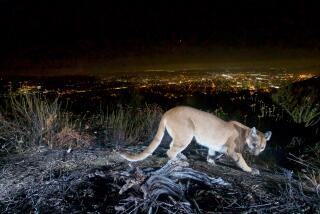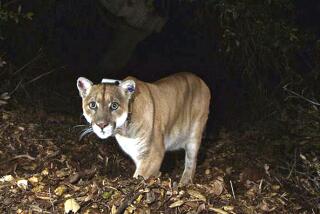A cuddly discovery in the Santa Monica Mountains: Four mountain lion kittens
Jeff Sikich crawled into dense shrub in a streambed in a remote part of the Santa Monica Mountains in early August. There, hidden in the rustling shrubs, were four blue-eyed babies — a quartet of mountain lion kittens.
The tiny cats tried to make a run for it, but they didn’t get far.
For the record:
7:55 p.m. Sept. 5, 2018A previous version of this article referenced obstacles posed by the 101 and 15 freeways to the Santa Monica Mountains cougars and stated there have been nine crossings of both freeways in the last 16 years. The cougars in the Santa Monicas are hemmed in by the 101, not the 15, and there have been about 10 crossings of the 101, not the 15, in that time. The National Wildlife Federation’s campaign for an overpass also focuses on the 101, not the 15.
“They’ll hiss. They try to move and bite,” said Sikich, who scooped up the kits while Mom was away. At 3 ½ weeks old, their tiny teeth couldn’t do much damage to the researchers.
The babies are a pleasant discovery for the team, which is studying mountain lion behavior in an increasingly urbanized environment. It means the large cats are continuing to mate successfully, giving the local species a greater chance at survival, Sikich said.
But it also spells a potentially ominous future for the predators. The newborns — named P-70, P-71, P-72 and P-73 by scientists — are believed to be products of inbreeding, which can cause birth defects, reproduction problems and, eventually, extinction.
The kittens’ father is thought to be P-56, who also is a product of inbreeding and is the grandson of the babies’ mother, P-19. This is the fourth litter for the 8-year-old mom.
The good news is the kittens appear to be healthy, Sikich said. Researchers temporarily moved the babies to a nearby workstation, where they took tissue samples and tagged the kits before quickly returning them to their den.
As the kittens age, they will face the same geographic problems as other mountain lions in the region, who are hemmed in by highways. The 101 Freeway is especially problematic for the big cats in the Santa Monicas. In 16 years, mountain lions have crossed the 101 only about 10 times, according to the National Park Service.
Their inability to expand their territory prevents the animals from mating with a larger variety of cats in the Santa Susana and Sierra Madre mountains to the north.
“Our population in the Santa Monica Mountains has some of the lowest genetic diversity documented, outside the Florida mountain lion,” Sikich said.
Based on a 2016 study, researchers learned that if no new animals breed with the existing population, inbreeding depression — the presence of birth defects and sterility — would be apparent in 35 years. Within 50 years, inbreeding could lead to the extinction of the local mountain lion population, he said.
Advocates led by the National Wildlife Federation are raising money for a wildlife overpass on the 101 that would help mountain lions and other animals cross the busy highway safely. The bridge could be completed by 2022.
UPDATES:
7:55 p.m.: This article was updated to clarify the number of cougars that have crossed the 101 Freeway and the target of the campaign to build a wildlife overpass.
This article was originally published at 10:55 a.m.
More to Read
Sign up for Essential California
The most important California stories and recommendations in your inbox every morning.
You may occasionally receive promotional content from the Los Angeles Times.











